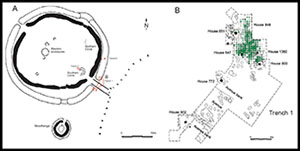Crossref Citations
This article has been cited by the following publications. This list is generated based on data provided by
Crossref.
Wright, Elizabeth
Viner-Daniels, Sarah
Parker Pearson, Mike
and
Albarella, Umberto
2014.
Age and season of pig slaughter at Late Neolithic Durrington Walls (Wiltshire, UK) as detected through a new system for recording tooth wear.
Journal of Archaeological Science,
Vol. 52,
Issue. ,
p.
497.
Thomas, Julian
2016.
Cattle, consumption and causewayed enclosures (response to Parmenter, Johnson and Outram).
World Archaeology,
Vol. 48,
Issue. 5,
p.
729.
Jones, Sharyn
2016.
Anthropological Archaeology in 2015: Entanglements, Reflection, Reevaluation, and Archaeology beyond Disciplinary Boundaries.
American Anthropologist,
Vol. 118,
Issue. 2,
p.
301.
Roe, Maggie
2016.
Editorial: food and landscape.
Landscape Research,
Vol. 41,
Issue. 7,
p.
709.
White, William M.
2017.
Encyclopedia of Engineering Geology.
p.
1.
Matlova, Veronika
Roffet-Salque, Mélanie
Pavlu, Ivan
Kyselka, Jan
Sedlarova, Ivona
Filip, Vladimir
and
Evershed, Richard P.
2017.
Defining pottery use and animal management at the Neolithic site of Bylany (Czech Republic).
Journal of Archaeological Science: Reports,
Vol. 14,
Issue. ,
p.
262.
Roffet-Salque, Mélanie
Dunne, Julie
Altoft, David T.
Casanova, Emmanuelle
Cramp, Lucy J.E.
Smyth, Jessica
Whelton, Helen L.
and
Evershed, Richard P.
2017.
From the inside out: Upscaling organic residue analyses of archaeological ceramics.
Journal of Archaeological Science: Reports,
Vol. 16,
Issue. ,
p.
627.
Bevan, Andrew
Colledge, Sue
Fuller, Dorian
Fyfe, Ralph
Shennan, Stephen
and
Stevens, Chris
2017.
Holocene fluctuations in human population demonstrate repeated links to food production and climate.
Proceedings of the National Academy of Sciences,
Vol. 114,
Issue. 49,
Kindstedt, Paul S.
2017.
Global Cheesemaking Technology.
p.
1.
Oras, Ester
Tõrv, Mari
Jonuks, Tõnno
Malve, Martin
Radini, Anita
Isaksson, Sven
Gledhill, Andy
Kekišev, Ott
Vahur, Signe
and
Leito, Ivo
2018.
Social food here and hereafter: Multiproxy analysis of gender-specific food consumption in conversion period inhumation cemetery at Kukruse, NE-Estonia.
Journal of Archaeological Science,
Vol. 97,
Issue. ,
p.
90.
Gardner, Jonathan
2018.
Beneath the rubble, the Crystal Palace! The surprising persistence of a temporary mega event.
World Archaeology,
Vol. 50,
Issue. 1,
p.
185.
Fernandes, Ricardo
Eley, Yvette
Brabec, Marek
Lucquin, Alexandre
Millard, Andrew
and
Craig, Oliver E.
2018.
Reconstruction of prehistoric pottery use from fatty acid carbon isotope signatures using Bayesian inference.
Organic Geochemistry,
Vol. 117,
Issue. ,
p.
31.
Graff, Sarah R.
2018.
Archaeological Studies of Cooking and Food Preparation.
Journal of Archaeological Research,
Vol. 26,
Issue. 3,
p.
305.
White, William M.
2018.
Encyclopedia of Geochemistry.
p.
561.
O'Connor, Terry
2019.
Pinned Down in the Trenches? Revisiting environmental archaeology.
Internet Archaeology,
Madgwick, R.
Lamb, A. L.
Sloane, H.
Nederbragt, A. J.
Albarella, U.
Pearson, M. Parker
and
Evans, J. A.
2019.
Multi-isotope analysis reveals that feasts in the Stonehenge environs and across Wessex drew people and animals from throughout Britain.
Science Advances,
Vol. 5,
Issue. 3,
Twiss, Katheryn C.
2019.
The Archaeology of Food.
Charlton, Sophy
Ramsøe, Abigail
Collins, Matthew
Craig, Oliver E.
Fischer, Roman
Alexander, Michelle
and
Speller, Camilla F.
2019.
New insights into Neolithic milk consumption through proteomic analysis of dental calculus.
Archaeological and Anthropological Sciences,
Vol. 11,
Issue. 11,
p.
6183.
Worley, Fay
Madgwick, Richard
Pelling, Ruth
Marshall, Peter
Evans, Jane A.
Lamb, Angela L.
López-Dóriga, Inés L.
Bronk Ramsey, Christopher
Dunbar, Elaine
Reimer, Paula
Vallender, John
and
Roberts, David
2019.
Understanding Middle Neolithic food and farming in and around the Stonehenge World Heritage Site: An integrated approach.
Journal of Archaeological Science: Reports,
Vol. 26,
Issue. ,
p.
101838.
Bradley, Richard
2019.
The Prehistory of Britain and Ireland.



